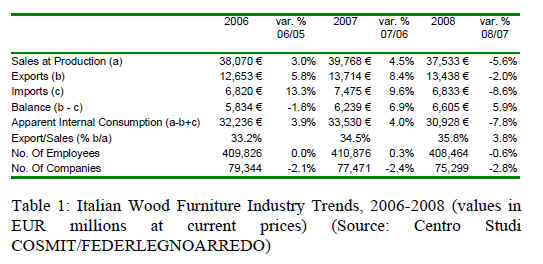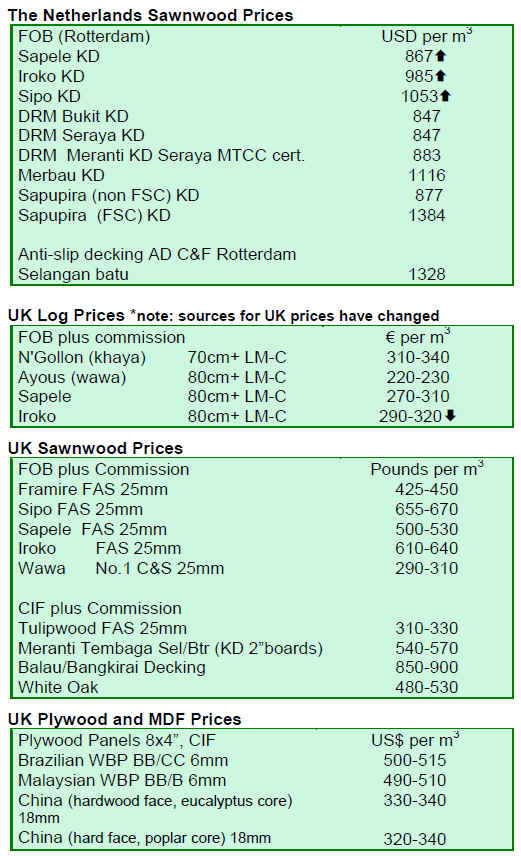|
Report
from
Europe, the UK
and
Russia
Export demand for Italian furniture proves resilient
The Italian furniture sector held up reasonably well to the
end of 2008 considering the scale of the economic
downturn. Preliminary 2008 end-year figures suggest that
Italian sales of wood furniture fell by 5.6% in 2008
compared to the previous year. Much of the decline in
sales was due to a fall in the overall level of Italian
domestic furniture consumption. The value of Italian wood
furniture exports fell by only 2%. The likelihood is that the
Italian furniture sector extended its share of the global
wood furniture sector in 2008. The latest available
international data indicates that the share of Italian
furniture on the global market in 2007 reached 9.1%,
rising from 8.9% in 2006.

After the sharp upturn in overseas sales during 2006 and
2007, a 2% drop in exports is by no means a positive
result. However, it is an indication that Italian furniture
products remain highly competitive in international
markets. During 2008, there was a severe downturn in
Italian furniture exports to two markets worst hit by the
credit crunch, the UK (-13%) and the US (-22%), together
with Germany (-5%) and Spain (-14%). However, these
losses were offset by strong gains in exports to Russia
(+17%), the United Arab Emirates (+37%), and Greece
(+4%). Exports to France and Austria remained stable.
Two factors had a bearing on the drop in Italy¡¯s domestic
furniture consumption in 2008. On the one hand, there was
a severe loss of consumer confidence during 2008 and, on
the other, there was a significant slump in the real estate
and rental markets even before the construction industry
was hit by a sharp fall in demand.
But overall, Rosario Messina, President of the Italian
wood furniture association Federlegno Arredo, believes
the figures are a reason for optimism. ¡®This is a crisis that
is being imported, quite unlike those in the past which
were all linked largely to a gap in our country¡¯s
competitiveness and in part to our business system. We are
stronger now: we have had time to absorb the competitive
shock generated by embracing the Euro and spot exchange
rates that were far from favorable to Italian exports. We
have taken stock of an increasingly global market and of
the difficulties inherent in true internationalization. Much
still remains to be done, but businesses have responded
well....the fact that Italian companies suffered to a lesser
extent than others on the international markets is largely
attributable to the quality of our products¡¯.
Italian furniture companies have certainly been hit by the
crises and small artisan businesses in particular have
registered an overall decline of 2.6% in numbers.
However, employment figures have been holding up.
According to Rosario Messina there are very definite
reasons for this: ¡®at times like these family-run businesses
[which dominate the Italian furniture industry] are in a
position to tighten their belts and focus on medium-term
objectives. There are many cases in which families have
fallen back on their own reserves during a credit crunch or
a lack of liquidity and, equally, family-run businesses
offer greater flexibility in terms of choice when times are
hard. When entrepreneurs identify with their own
businesses, they are less likely to make staff cuts, tending
to view these as a last resort. This in turn avoids setting a
vicious circle of consumer uncertainty and cutbacks in
motion, which then rebounds on the businesses
themselves¡¯.
These comments might provide some crumbs of comfort
to timber importers in Italy, but it is also clear that the
benefits of the furniture sector¡¯s apparent resilience have
yet to filter through to the wood trade. Trade data suggests
that the Italian wood sector suffered more severely than
the furniture sector during the latter months of 2008. This
was due in part to widespread destocking by furniture and
joinery manufacturers in response to the uncertain
economic conditions and also to a sharp downturn in
construction sector activity. According to Federlegno
Arredo, Italian wood industry sales fell by 7.5% (an
overall total of approximately 15 billion Euros) in 2008
compared to the previous year, mainly due to a decline in
Italy¡¯s internal wood consumption which plummeted by
9.1%.
Salone del Mobile furniture show reflects market resilience
The Salone del Mobile in Milan is perhaps the most
significant furniture show in the world where a huge
number of exhibitors jostle for attention, many employing
the services of some of the world¡¯s top designers. In terms
of sheer volume of production, Italy was recently
overtaken by China as the world¡¯s largest furniture
manufacturing country. However the Italian furniture
sector generally, and the Salone show in particular,
continues to have a huge impact on furniture fashion
trends in all areas of the world.
A key part of the Italian furniture sector resilience during
the global downturn has been a heavy emphasis on design
and marketing. Underlining the determination of the
Italian furniture sector to stay on top, or perhaps a
reflection of greater desperation to generate demand
during the economic downturn, this year¡¯s Salone show
boasted a huge increase in the numbers of exhibitors
compared to last year. The show, which ended on 27
April, hosted 2,723 exhibitors (of whom 911 were non-
Italians) and covered an exhibition area of 202,350 square
meters. In 2008, there were 1,068 Italian and 230 foreign
exhibitors and the overall exhibition area stood at 152,207
square meters.
The key question doing the rounds of insiders in the runup
to the Salone show was this: ¡®How will manufacturers
and designers respond to the crisis that has the world
economy in its grip?¡¯ The show¡¯s publicists, based on their
own survey of products on display, felt that the economic
downturn had contributed to two contrasting trends in
Italian furniture design. They note that ¡®some designers
and firms have striven for greater pragmatism, a more
balanced relationship between object and cost and a
greater focus on consumer demand. Others have sought
refuge in escapism. An important element of this trend has
been to link furniture design to the world of nature¡¯.
The first approach is believed to have led to an
¡®unexpected return to minimal¡¯, scaling down the
decorative explosion of the last few years. There is greater
emphasis on timeless objects that are built to last rather
than paying lip service to passing fashions. There is an
emphasis on ¡®gracious¡¯, non-aggressive designs that can
¡®stray¡¯ from one room of the house to the next.
Many of the wood furniture items on show adhered to the
minimalist ideal. The Dutch furniture company Arco was
displaying a table manufactured 100% in wood with no
metal or other elements. The simplicity of the design
combined with use of real wood veneers and avoidance of
other potentially expensive materials meant the product
was extremely cost efficient. Another example is the Eno
chair in black oak designed by Mikko Lakkonen for Covo.
Other exemplars of the minimalist look in wood were the
Italian FEG company, the Swiss Mobimex, and the Italian
Mathias company.
There was a strong preference in these modern minimalist
designs either for very dark brown, often black woods, or
for whitened woods. Walnut was used most extensively to
achieve the darker colors. Wenge was occasionally seen,
although much more typically oak was stained to achieve
the black look. Ash was often painted for the white look.
Another common theme was to combine a minimalist
design with a more exotic finish. A simple chair or table
may be manufactured in a heavily grained even stripey
wood, or in plywood cross-cut to produce an interesting
look. A particularly good example was the Gem 743 table
designed by Gianni Astolfi and Sergio Mian for the
Mathias company in ziricote (Cordia dodecandra), a
tropical hardwood from Central America.
The second trend towards ¡®escapism¡¯ and ¡®naturalism¡¯ had
even clearer implications for the use of wood, particularly
tropical. According to the show publicists, this trend has
contributed to the strong emergence of outdoor furniture
(often with a dual ¡®outdoor/indoor¡¯ function). They note
that ¡®outdoor collections are multiplying; costlier materials
and finer designs are being employed¡¯.
It was evident from the show that while tropical wood is
benefiting to some extent from this trend, it now has to
share the outdoor furniture sector with a huge range of
other materials. Gone are the days when teak was
dominant, a reflection both of a fashion for mixed
materials and the increasing difficulties of obtaining high
quality large dimension teak. Much of the outdoor
furniture on display at the Salone show was manufactured
from plastic, steel, aluminium and fabric.
Alternative woods were also being used for exterior
furniture. The Belgian company Tribu was promoting a
new line of garden furniture made of painted acacia wood.
Schonhuber Franchi now combines teak with aluminium
and is also promoting a line of aluminium/palissandro
products. Fornasarig was displaying outdoor furniture by
Japanese designers Shinibu and Setsu in treated oak
chosen primarily for its ability to produce curvatious
designs. Gloster, while maintaining their strong loyality to
teak, were introducing a new design which combines the
tropical wood with copious quantities of soft material for a
more comfortable look.
The concepts of ¡®escapism¡¯ and ¡®nature¡¯ were also major
influences in the indoor furniture sector. While designers
were interpreting these themes in a huge variety of ways,
certain threads tended to be repeated, such as the
widespread use of natural fibers and reclaimed materials,
and of non-geometric ¡®rough¡¯, ¡®ethnic¡¯ and ¡®rural¡¯ designs.
The Italian Riva company were particularly firm adherents
to the ¡®natural¡¯ concept. Their stand was dominated by a
huge timber board 12 meters in length and 2 meters wide
carved from a New Zealand kauri tree (agathis australis).
The theme of the stand was ¡®eco-design¡¯, Riva having
brought together around 20 of the world¡¯s top furniture
designers to create unique furniture, all in real wood. The
company claims to use only sustainably managed woods ¨C
although interestingly there was no reference to any
specific sustainable forestry standard or labeling system
such as FSC or PEFC (in fact no-one seemed to be visibly
promoting either of these labels at the show). Instead, Riva
emphasizes its heavy reliance on American hardwoods.
All the products on display were manufactured in
American black walnut.
Generally, tropical timbers were not strongly featured in
the visual elements of indoor furniture displayed at the
show. The only exception was Indian rosewood (Dalbergia
latifolia) used widely in veneer form to produce a highly
exotic and glossy striped finish on more classic furniture
lines. There was a little teak favored for the darker brown
grainy look which is currently in fashion. In line with the
¡®natural¡¯ and ¡®rustic¡¯ themes, there were also a few
companies displaying furniture in reclaimed teak. Tropical
redwoods appear to be very much out of fashion in the
European furniture sector. But closer examination of some
furniture items revealed a bit of tropical wood under the
skin. For example, mahogany was occasionally being used
for frames in high quality classic furniture lines where it is
valued for its strength and stability.

¡¡
|